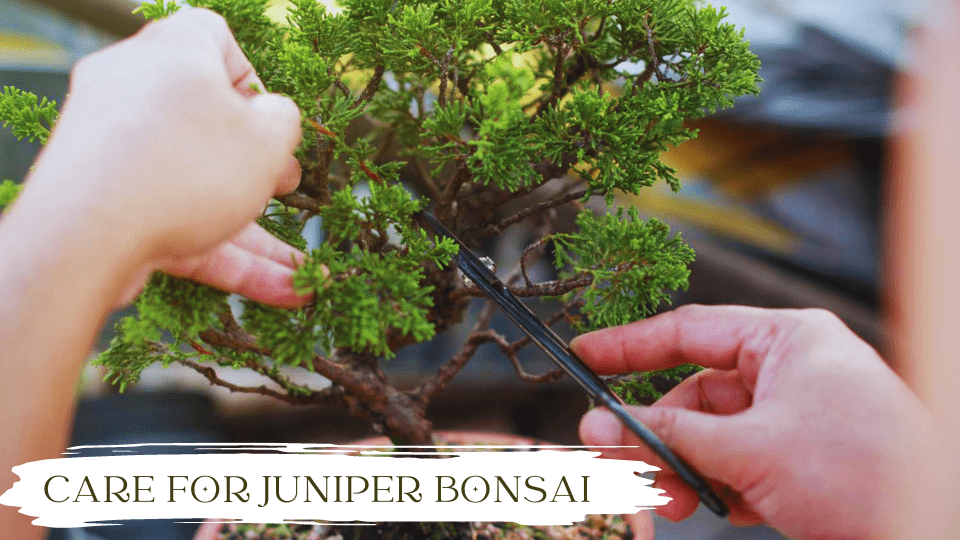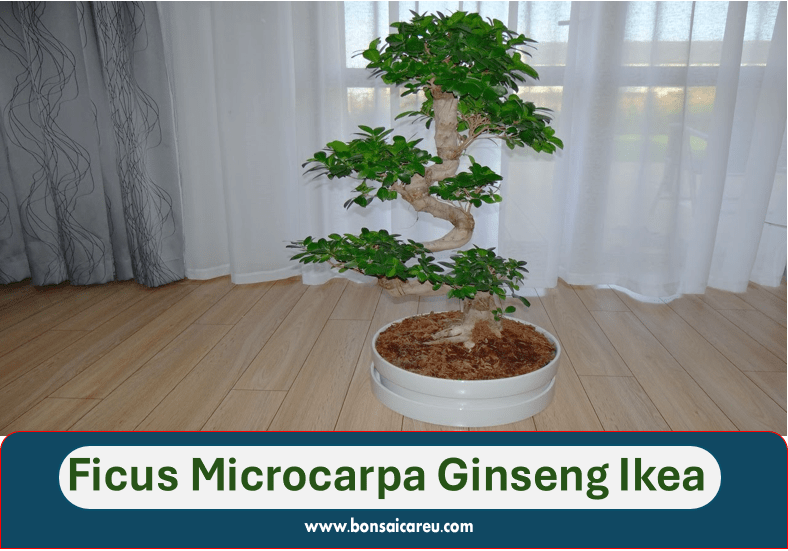How to Care for Juniper Bonsai: ensure it gets plenty of sunlight and water when the soil feels dry. Juniper bonsai requires regular pruning and fertilizing to maintain its shape and health.
Additionally, please protect it from extreme temperatures and report it every two years to maintain its growth and appearance. When watering, make sure to water the soil evenly and avoid waterlogging. Juniper bonsai also benefits from occasional misting to increase humidity.
With proper care, your juniper bonsai will thrive and bring natural beauty to your space.

How to Care for Juniper Bonsai
Discover the art of caring for Juniper Bonsai with essential watering, pruning, and sunlight exposure tips. Ensure proper drainage and avoid overwatering to maintain the health and beauty of your Juniper Bonsai. Remember to provide adequate sunlight and regular fertilization for optimal growth.
Origins And Significance
Juniper bonsai, originating from Japan and China, holds great cultural and spiritual significance in the art of bonsai. These miniature trees are carefully cultivated to represent the beauty and harmony found in nature. The ancient practice of bonsai has been revered for centuries, with each tree reflecting its caretaker’s skill and artistic vision.
Characteristics Of Juniper Bonsai
Juniper bonsai trees are known for their distinctive features that make them ideal for bonsai cultivation. These trees possess small, needle-like leaves that add to their delicate aesthetic. The gnarled and twisted trunks of juniper bonsai tell a story of strength and resilience, further enhancing their charm. With their ability to withstand harsh conditions and adapt to different environments, juniper bonsai trees symbolize endurance and perseverance.
When caring for a juniper bonsai, it is important to understand and appreciate the unique characteristics that make these trees so captivating. By nurturing their growth, you can help preserve the artistry and tradition of juniper bonsai.
Selecting Your Juniper Bonsai
Selecting your Juniper Bonsai involves choosing a healthy plant with vibrant green foliage and a sturdy trunk. Ensure proper care by placing it in a sunny spot, watering when the soil feels dry, and providing well-draining soil to thrive. Regular pruning and shaping will help maintain its elegant appearance.
Selecting the right juniper bonsai can greatly improve the long-term health and beauty of your plant. Several factors should be considered before making your purchase, including the type of juniper, the size of the plant, and the overall health of the bonsai. In this article, we will explore these factors and provide tips on where to purchase your juniper bonsai.
Rock Juniper Bonsai Tree Care
Factors To Consider
When selecting your juniper bonsai, you should consider the following factors:
- Type: There are several different types of juniper bonsai, each with its own unique characteristics. Some popular types include the Shimpaku Juniper, the Green Mound Juniper, and the Procumbens Nana Juniper. Consider the look and size of each type before making your selection.
- Size: Juniper bonsai come in a variety of sizes, from small tabletop plants to larger outdoor trees. Consider the space you have available for your bonsai and choose a size that will fit your needs.
- Health: Look for a juniper bonsai that appears healthy and vibrant. Avoid plants with yellowing leaves, brown spots, or signs of insect damage. A healthy plant will have strong, green foliage and a sturdy trunk.
Where To Purchase
You can purchase juniper bonsai from a variety of sources, including nurseries, online retailers, and bonsai specialty stores. When choosing a retailer, consider the following:
- Reputation: Look for a retailer with a good reputation for quality plants and customer service. Read reviews and ask for recommendations from other bonsai enthusiasts.
- Selection: Choose a retailer with a wide selection of juniper bonsai so you can find the perfect plant for your needs.
- Price: Compare prices from different retailers to ensure you are getting a fair deal. Keep in mind that larger plants and specialty varieties may be more expensive.
By considering these factors and choosing a reputable retailer, you can find the perfect juniper bonsai for your home or garden. With proper care and attention, your bonsai will thrive and bring beauty to your space for years to come.
Ideal Growing Conditions
When it comes to caring for your Juniper Bonsai, providing the ideal growing conditions is crucial to its health and vitality. Creating a suitable environment will ensure that your bonsai thrives and remains resilient against common issues. Let’s explore the key factors to consider when creating the ideal growing conditions for your Juniper Bonsai.
Sunlight And Temperature
Juniper Bonsai thrives in bright, indirect sunlight and requires at least 4-6 hours of light each day. Place it near a south-facing window to ensure it receives an adequate amount of sunlight. The ideal temperature for Juniper Bonsai ranges from 60°F to 75°F, so it’s important to keep it in a location with consistent, moderate temperatures.
Humidity And Air Circulation
Ensuring proper humidity levels is essential for the health of your Juniper Bonsai. You can increase humidity by placing the bonsai pot on a humidity tray filled with water and pebbles. Additionally, regular air circulation is important to prevent stagnant air around the bonsai, leading to mold and mildew issues.
Watering And Feeding
Caring for a Juniper Bonsai involves proper watering and feeding techniques. The right watering and fertilization schedules are crucial for the health and vitality of your bonsai tree.
Watering Techniques
Juniper Bonsai trees require well-drained soil to prevent waterlogging. Allow the soil to dry between watering to avoid root rot partially.
- Check the moisture level by inserting your finger into the soil
- Water thoroughly when the top inch of the soil feels dry
- Avoid overwatering, as it can lead to root rot
Fertilization Schedule
Feeding your Juniper Bonsai with the right nutrients is essential for its growth and development. Here’s a simple fertilization schedule to follow:
| Month | Fertilizer Type | Frequency |
|---|---|---|
| Spring | Balanced liquid fertilizer | Every 2 weeks |
| Summer | Organic slow-release fertilizer | Once a month |
| Fall | Low-nitrogen fertilizer | Every 6 weeks |
| Winter | Do not fertilize | N/A |
Pruning And Shaping Mastery
Master the art of pruning and shaping to care for your Juniper Bonsai effectively. By skillfully trimming and styling your bonsai tree, you can promote healthy growth and create a stunning aesthetic appeal for your miniature masterpiece.
Pruning Basics
Pruning is an essential practice when it comes to caring for your Juniper Bonsai. It helps maintain the shape, health, and overall appearance of the tree. To start, make sure you have the necessary tools, such as sharp pruning shears or scissors. Begin by removing any dead, damaged, or diseased branches. This not only improves the aesthetic appeal but also prevents the spread of diseases. Remember to cut at an angle, leaving a small stub, to promote healing. Regularly trim the foliage to maintain the desired shape and size of your bonsai.
Advanced Shaping Techniques
Once you have mastered the basics of pruning, you can move on to advanced shaping techniques to truly showcase the beauty of your Juniper Bonsai. One technique is known as “wiring,” which involves wrapping aluminum or copper wire around the branches to guide their growth. This allows you to create unique and artistic shapes. Be careful not to wrap the wire too tightly, as it can damage the branches. Another technique is “pinching,” where you use your fingers to remove the tips of new growth. This encourages the development of more compact foliage pads. Remember to be patient and gentle when shaping your bonsai, as it takes time for the tree to adjust and respond to these techniques. By mastering the art of pruning and shaping, you can create a visually stunning Juniper Bonsai that reflects your personal style and creativity. Regularly pruning and shaping your bonsai not only enhances its appearance but also promotes its overall health and longevity. Remember to always research and learn about the specific needs of your Juniper Bonsai, as different varieties may require slightly different care techniques. With practice and dedication, you will become a pruning and shaping master, able to transform your bonsai into a true work of art.
Common Pests And Diseases
Common Pests and Diseases can affect the health of your Juniper Bonsai. It’s important to be able to recognize the signs of these issues and take appropriate action to prevent and treat them effectively.
Identifying Pests And Diseases
Signs of common pests and diseases in Juniper Bonsai include yellowing or browning of leaves, unusual spots, and webbing.
Prevention And Treatment
- Regularly inspect your bonsai for any signs of pests or diseases.
- Keep your Juniper Bonsai healthy with proper watering and sunlight.
- Use natural remedies like neem oil for pest control.
Frequently Asked Questions
How Do You Care For An Indoor Juniper Bonsai Tree?
To care for an indoor juniper bonsai tree, place it in a bright spot with indirect sunlight. Water the tree thoroughly when the topsoil feels dry. Avoid overwatering or letting the soil dry out completely. Prune the tree to maintain its shape and remove dead or yellowing leaves.
Fertilize the tree once a month during the growing season.
How Often Should I Water A Juniper Bonsai?
Water your juniper bonsai when the topsoil feels dry to the touch. Typically, it needs water every 2-3 days. Adjust based on humidity and sunlight. Overwatering can harm the plant, so ensure proper drainage.
Do Juniper Bonsai Trees Need Direct Sunlight?
Yes, juniper bonsai trees need direct sunlight for at least 4-6 hours a day. It’s crucial for their growth and development.
Are Juniper Bonsai Good For Beginners?
Yes, juniper bonsai are good for beginners due to their resilience and adaptability. They are easy to care for and can tolerate a wide range of growing conditions. Junipers also have a unique aesthetic appeal, making them a popular choice for bonsai enthusiasts of all levels.
How Often Should I Water My Juniper Bonsai?
Water your Juniper Bonsai when the topsoil feels dry to the touch to avoid overwatering.
What Is The Best Location For A Juniper Bonsai?
Place your Juniper Bonsai outdoors in a spot with full sun exposure for optimal growth.
Conclusion
Caring for juniper bonsai requires attention to detail and patience. Watering, pruning, and fertilizing are essential for the health and longevity of the plant. Additionally, understanding the specific needs of your juniper bonsai, such as light and temperature requirements, can help it thrive.
By following these tips and regularly checking on your juniper bonsai, you can enjoy the beauty of this unique plant for years to come.


